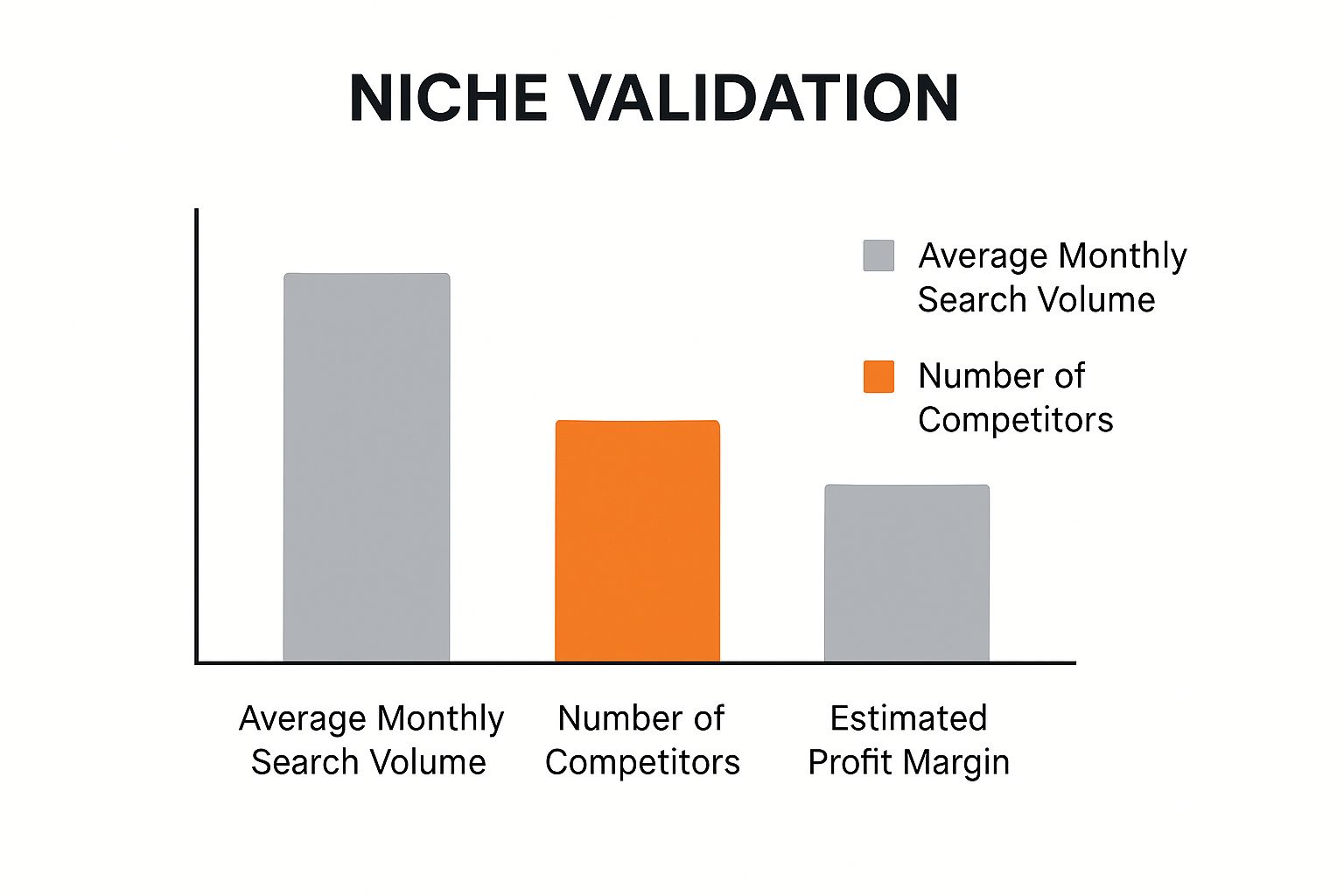The real trick to finding a profitable niche isn't some grand, innovative idea that pops into your head in the shower. It's about finding a specific, nagging problem that a group of people is desperate to solve. I’ve seen time and again that the most successful founders are the ones who start by listening—really listening—to what people are complaining about on platforms like Reddit, then using that raw data to validate a need before writing a single line of code.
Uncovering Problems Worth Solving

Forget about clever marketing gimmicks or complex keyword research for a moment. The foundation of every great niche business is a genuine, persistent problem that people will happily pay to make go away.
Instead of starting with a product and searching for a market, you need to flip the script. Start with the pain point. Your job is to become a master listener, tuning into the unfiltered, candid conversations happening online every single day. This means getting away from sterile market reports and diving into the messy, honest world of real user frustrations.
Tapping into Unfiltered Customer Needs
Online forums and communities are absolute goldmines for this kind of reconnaissance. Reddit, in particular, is where people go to vent, ask for help, and share problems they wouldn't dream of posting on their polished LinkedIn profiles. The anonymity breeds honesty, giving you a direct line to what truly irritates potential customers.
As a bootstrapper or solopreneur, your time is everything. You can't afford to spend days manually sifting through thousands of posts hoping to strike gold. This is where you can be smart and use specialized tools.
A tool like ProblemSifter does more than just spit out generic ideas. It directly connects you to the very Reddit users who are asking for a solution. It scans communities and hands you not just the problem, but the original post and even the usernames of the people who expressed that pain point.
This method gives you two massive advantages. First, you get startup ideas already validated by real demand. Second, you get a ready-made list of your first potential customers—people you can reach out to for honest feedback, interviews, and eventually, their business. You're turning abstract research into a direct line to your future user base.
If you want to dig deeper into this approach, we have a whole guide on how to find the problem before you even think about the solution.
From Complaints to Opportunities
As you browse these communities, keep an ear out for recurring themes and emotionally charged language. When you notice a dozen people complaining about the same piece of clunky software, a critical missing feature, or a mind-numbing manual task, you've found a strong signal. These aren't just rants; they're market opportunities laid bare.
Your goal is to collect these pain points. Be on the lookout for specific phrases that scream "opportunity":
- "I wish there was a tool that could..."
- "Does anyone have a solution for...?"
- "I'm so fed up with trying to..."
This is the language of unmet needs. By building something that directly answers these pleas, you dramatically reduce the risk of building something nobody wants. You're not guessing anymore. You’re building what people have already told you they need, which is the most efficient way to create value from day one.
Using Community Data to Validate Niche Ideas

An idea is just a hypothesis until you prove it. The single most important step separating a future success from a costly mistake is validation. Forget generic market reports. The smartest founders I know practice micro-validation—they prove their concept on a small scale by digging into real user conversations before they sink a ton of time or money into a project. This is how you discover if your niche idea actually has legs.
Online communities, especially platforms like Reddit, are perfect for this kind of detective work. They're raw, unfiltered ecosystems where people share frustrations and ask for help with a level of honesty you just don't find anywhere else. The passion, the volume of discussion, and the specific language people use are all powerful signals of a niche's potential.
Turning Raw Data into Real Leads
The goal here isn't just to confirm a problem exists. It's about figuring out who has it and how they talk about it. This is the secret to finding profitable niches that come with a built-in audience. You could spend weeks manually sifting through forums, but that’s a slow, painful grind. You need a faster way to pinpoint specific pain points.
This is where a specialized tool becomes a solopreneur's best friend.
Unlike other tools, ProblemSifter doesn’t just suggest ideas—it connects you to the exact Reddit users asking for them. It gives you the original post and even the usernames of people describing a specific pain point, effectively turning anonymous data into a list of warm leads.
This direct connection is a total game-changer. You can go from identifying a problem to actually talking with potential customers in minutes, not weeks. It dramatically cuts the risk of building something nobody wants because you’re essentially co-developing your solution with the very people who will end up using it.
From Validation to a Go-To-Market Plan
Validating with community data gives you more than just confidence. It hands you a roadmap for your launch. By analyzing these conversations, you learn the exact words your target audience uses to describe their challenges. This is your future marketing copy, served up on a silver platter.
When you're finally ready to launch, you already know where your first customers hang out. You can return to those same Reddit threads and communities with a solution built specifically for their stated needs. This isn't cold outreach; it's showing up with a direct answer to a public request for help.
This highly targeted approach gives you a massive advantage over broad, expensive ad campaigns. It's precise, efficient, and helps you build a loyal base of early adopters who feel seen and understood.
Here's why this method works so well:
- Direct User Connection: You get past abstract data and find real people with real problems.
- Customer Development: The Reddit usernames provided are your first interview list for gathering crucial feedback.
- Targeted Promotion: You can launch your product directly to users who have already confirmed they need it.
For just $49, you can get lifetime access to a curated list of real startup problems people are discussing in a specific subreddit. ProblemSifter keeps things simple with one-time pricing—$49 for one subreddit, $99 for three—so there are no recurring subscriptions or hidden fees. It’s an incredibly accessible and powerful tool for founders working with a tight budget.
Assessing Market Size and Growth Potential
 Finding a real-world problem is a great start, but passion alone won't pay the bills. A truly profitable niche needs a market that can actually support a business. Once you've locked onto a frustration people are desperate to solve, it's time to put on your analyst hat.
Finding a real-world problem is a great start, but passion alone won't pay the bills. A truly profitable niche needs a market that can actually support a business. Once you've locked onto a frustration people are desperate to solve, it's time to put on your analyst hat.
You need to verify that enough people share this problem and are willing to pay for a solution. The goal is to strike a balance between a tight-knit, underserved community and the raw financial necessity of growth potential. A passionate group of ten people won't build a business, but a massive, oversaturated market can be a brutal place to start.
What you're really looking for are the tell-tale signs of a healthy, growing ecosystem.
Gauging Demand with Data
The best way to begin is by looking at high-level trends to see where the money is flowing. A quick analysis of market size and growth can tell you if you're swimming in a growing pond or a shrinking puddle.
For example, look at the global subscription services sector—it's projected to hit $1.5 trillion by 2025. That’s a massive signal showing a fundamental shift in consumer behavior. This boom covers everything from software to meal kits, confirming that recurring revenue is a powerful model. Similarly, the trend toward personalization has fueled markets like print-on-demand, which is on track to reach nearly $18 billion by 2028.
Spotting sub-niches within these booming megatrends gives you an immediate advantage. This top-down view helps align your idea with powerful economic currents, which makes it much easier to attract customers and, eventually, even investors.
Finding Profit in Sub-Niches
The biggest opportunities are rarely found by taking on a huge market head-on. The real money is often made by carving out a specific corner for yourself—a place where you can become the undisputed leader.
A common mistake I see entrepreneurs make is thinking competition is a bad sign. It’s the opposite. Competition is proof that a market exists and money is being spent. Your job isn't to find a market with zero players, but to find a gap the current players are ignoring.
Let's take a massive market like "project management software." Instead of trying to out-feature the giants, you could zero in on a sub-niche. Think "asynchronous project tools for remote creative agencies." Suddenly, your path becomes much clearer.
This approach gives you a few powerful advantages:
- Less Direct Competition: You’re no longer in a direct dogfight with the biggest names in the industry.
- Focused Marketing: Your message can be laser-targeted to resonate deeply with a very specific audience.
- Clearer Product Roadmap: Building for a distinct user with well-defined needs simplifies every feature decision.
This strategic focus lets you become the go-to solution for a specific group, giving you a strong foothold to build from. If you're still weighing different ideas, our guide on what business you should start provides more frameworks for this critical decision.
By combining big-picture market analysis with a targeted sub-niche strategy, you start building a rock-solid case for your niche's long-term profitability.
Building Your Niche Research Toolkit
Finding a great niche isn't about guesswork; it's about having the right tools to turn raw data into a clear plan. For founders, especially indie hackers and solopreneurs, the best toolkit isn't just about standard SEO platforms. It's about finding tools that help you listen in on real conversations and uncover genuine problems, not just chase keywords.
Your goal is to assemble a small, powerful set of resources that help you tap into authentic discussions, validate demand with real user data, and even start connecting with your first potential customers before you've built a thing.
Moving Beyond Keywords to Find Problems
Let's be clear: traditional SEO tools have their place. They're fantastic for gauging search volume and understanding what people are looking for. But they don't tell you the why behind the search. They reveal the what, not the problem driving it, and that's a critical distinction when you're trying to build something people will actually pay for.
This is where a different kind of tool comes into play—one that plugs you directly into community data and user-generated content. These platforms let you hear the unfiltered voice of your future audience.
The best insights I've ever had came from listening to real people talk about their frustrations. You're not just looking for low-competition keywords; you're hunting for high-pain problems. That's the bedrock of a solution worth building.
The Indie Hacker's Toolkit for Niche Discovery
You don't need to drown in a sea of subscriptions. A lean, focused toolkit is far more effective. I've found that the tools delivering the most bang for your buck fall into a few key categories.
- Community Scrapers: Think of tools designed to mine forums like Reddit. They're brilliant for spotting recurring questions, wish-list features, and common complaints about the tools people are already using.
- Trend Analysis Tools: A classic for a reason. Google Trends helps you see if interest in a topic is growing, so you can tell a lasting market shift from a fleeting fad.
- Direct Validation Tools: These are the real gems. They don't just find abstract problems; they connect you with the very people who have them.
A standout in this last category is a tool I've used called ProblemSifter. It's different. Instead of just giving you a list of ideas, it connects you to the exact Reddit users who are asking for a solution. You get the original post and the usernames of people describing a specific pain point. For a one-time fee of just $49 for lifetime access to a subreddit’s entire problem database, it gives you a direct line to both ideation and your first customer development calls. It's a massive advantage over pricey subscription tools that only give you high-level data.
Niche Research Tool Comparison For Founders
To help you decide where to invest your time and money, I've put together a quick comparison of the different types of tools you'll encounter. This table breaks down what each tool does best and why it might be a good fit for a founder just starting out.
| Tool Type | Primary Function | Common Pricing Model | Key Advantage For Founders |
|---|---|---|---|
| Traditional SEO Tools | Keyword research, competitor analysis, backlink tracking. | Monthly Subscription ($$$) | Great for sizing up a market after you have an idea. |
| Trend Analysis Tools | Tracking public interest in topics over time. | Free | Validates if a niche is growing, shrinking, or just a fad. |
| ProblemSifter | Connects problems on Reddit to the specific users who voiced them. | One-Time Fee ($) | Provides a ready-made list of people for customer interviews and targeted promotion. |
| Other Community Scrapers | Mining forums (e.g., Reddit, Indie Hackers) for pain points. | One-Time Fee or Subscription ($) | Uncovers problems in users' own words; good for general idea generation. |
Ultimately, a mix of these tools gives you the most complete picture. You might use a tool like ProblemSifter to find the initial problem and validate it with real users, Google Trends to check its longevity, and a traditional SEO tool to gauge the competitive landscape later on.
The chart below gives you a visual model for weighing the different factors once you've found a promising idea.

As you can see, the sweet spot is often a niche with moderate search volume, manageable competition, and a high potential profit margin. That's where a new founder can really make an impact.
By building your toolkit around direct user feedback, you stop guessing what people want and start knowing what they need. This approach doesn't just lead you to profitable niches—it gives you the customer insights you need to build a product that actually succeeds.
How Will You Actually Make Money?
Finding a great niche is a huge first step, but it’s only half the equation. The real trick is figuring out how to turn that promising idea into a business that actually pays the bills. Your monetization strategy can't be an afterthought—it needs to be woven into your thinking right from the start.
I've seen too many founders fall in love with a problem without ever stopping to ask if people would pay for a solution. The most successful entrepreneurs I know don't just find a problem; they find a problem that a specific audience is willing and able to pay to solve. Your revenue model has to be a natural fit for the community you’re serving.
Match Your Model to Your Market
There are plenty of ways to generate revenue, but the right one for you depends entirely on your niche. Let's break down some of the most common paths.
- Subscription Services: This is the golden goose for many indie hackers. Think SaaS, exclusive content, or curated boxes. It’s perfect for niches where you provide ongoing value.
- Digital Products: This is your world of ebooks, online courses, and design templates. It works beautifully when your audience needs to master a skill or solve a specific, one-time problem.
- Affiliate Marketing: Here, you earn a commission for recommending products you trust. It's a fantastic, low-risk starting point if you're building a content-heavy site where your audience looks to you for expert advice.
- Direct-to-Consumer (DTC): This is for when you're selling physical products. You own the entire customer journey, from the brand's story to the unboxing experience.
So, how do you choose? You have to get inside the heads of your future customers. You can learn a lot by digging into how to find your target audience and their deepest frustrations. Are they looking for a continuous service to make their lives easier, or a one-off purchase to fix an immediate pain? Their behavior dictates your strategy.
Why Recurring Revenue is a Game-Changer
For solo founders and small teams, recurring revenue is more than just a business model; it’s a lifeline. The predictable income that comes from subscriptions provides a stable foundation. Instead of constantly hunting for the next sale, you can focus your energy on making your product better. This isn't just a hunch; the market data screams it.
The global subscription market is projected to skyrocket to $1.5 trillion by 2025. This isn't a passing fad. It's a seismic shift in consumer behavior, driven by a demand for convenience and value.
This trend isn't limited to software. High-growth niches like print-on-demand are seeing explosive growth, with compound annual growth rates hitting 15-16%. People want unique, custom products. And even content creators can cash in—top finance bloggers, for instance, can pull in over $9,100 per month thanks to high ad rates and deeply engaged readers.
Ultimately, a winning monetization strategy comes down to a simple, powerful concept: know how your audience spends money. Your goal is to create a value exchange that feels so essential and seamless that they aren't just willing to pay—they're happy to.
Common Questions About Niche Selection
Even with the best strategy, picking a niche can feel paralyzing. It’s a big decision. Founders, indie hackers, and solopreneurs all get stuck on the same handful of questions. Let's walk through them, so you can stop second-guessing and start moving forward with confidence.
How Do I Differentiate a Fad From a Lasting Trend?
This is a classic. A fad is like a firework—a brilliant, exciting flash that’s gone just as quickly. It's usually driven by novelty or a sudden burst of hype. A real trend, however, has roots. It’s grounded in a fundamental shift in how people live, work, or what they value. Think about the massive move to remote work or the growing demand for sustainable products. These aren't just passing fancies.
So how do you tell the difference? Look for staying power. Is the conversation around this topic measured in years, not just a few frantic months? Are other businesses building supporting products and services around it? An entire ecosystem doesn't pop up around a fad.
Most importantly, ask yourself: does this solve a real, persistent problem? Fads cater to a temporary desire. Trends solve an evolving, long-term need.
What if My Chosen Niche Seems Too Competitive?
First off, take a breath. High competition isn't the warning sign most people think it is. It's actually a green light—one of the strongest indicators that a market is healthy, active, and, critically, profitable. People are already spending money there.
Instead of looking for an empty field with no customers, your goal is to find your specific spot in that crowded market.
Competition validates demand. Your task isn’t to find an empty field, but to find the gap in the existing solutions and build something that is 10x better for a specific group of people.
Your secret weapon is focus. Don't build "project management software." Build "project management software for solo freelance writers." Can you carve out a niche by offering a dramatically better user experience, simpler pricing, or a business model that customers actually prefer? That’s where you win.
How Can I Effectively Use ProblemSifter For Research?
ProblemSifter is a fantastic tool because it turns the firehose of Reddit conversations into a focused list of validated startup ideas. The trick is to use it strategically, not just browse randomly.
Start with what you know. Pick subreddits related to your passions or professional experience, like r/saas, r/sideproject, or r/solopreneur. Your goal is to spot patterns—recurring problems, frustrations with current tools, or specific feature requests that keep popping up. Pay close attention to the exact words people use. That's your future marketing copy, handed to you on a platter.
When you find a promising problem, ProblemSifter gives you the usernames of the people who posted about it. This is gold. You can reach out directly with a simple message, ask for a 15-minute chat to hear more, and start validating your idea. You can build a waitlist before you’ve written a single line of code.
Here's how it breaks down:
- Ideation: Find real, unfiltered problems on Reddit that people are desperate to solve.
- Validation: Get direct access to the very people—and their original posts—who have the problem.
- Promotion: Build a pre-launch list for targeted outreach to the same users who expressed the pain point.
This approach gives you a repeatable process for finding vetted ideas. For a one-time payment of $49 for lifetime access to a subreddit, you're essentially buying an engine for continuous idea generation and customer development.
Ready to stop guessing and start building something people will actually pay for? ProblemSifter cuts through the noise of Reddit and delivers a curated list of validated business ideas, complete with the usernames of people asking for them. Find your next profitable niche today.
